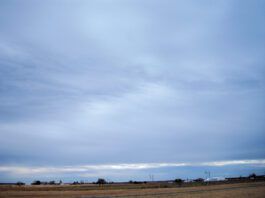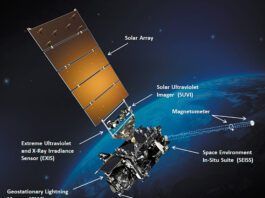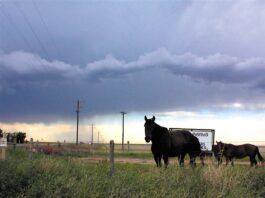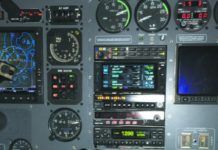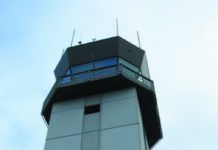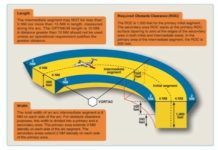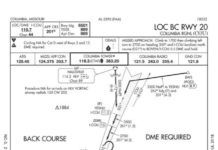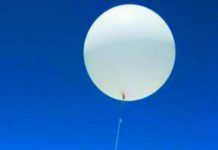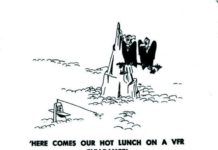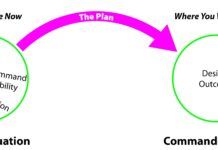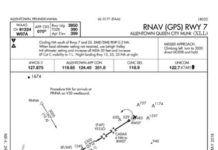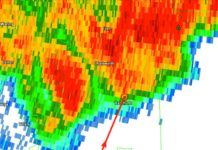Using Your Autopilot
The point here is that once George is flying, our mental paradigm becomes letting him fly and just telling him what to do. This occasionally results in way too much energy and button-mashing to make a last-minute change. Its ever so much simpler to be hand flying in the first place and, well, aim elsewhere. So, pick an altitude below which youll always hand fly. Perhaps its 1000 feet AGL, or maybe all the way down to 400 feet (but no lower).
One In or One Out
Before I can clear an airplane for a visual approach, I have to ensure the pilot has either the landing runway, the airport, or preceding aircraft in sight. Obvious, right? If youre landing on it or following it, ATC must ensure you can see it. For instance, if there are clouds in the way or the preceding aircraft gets lost in ground clutter or weather, theres no guarantee youll be able to safely navigate visually to the runway.
Ya Gotta Fly a DME Arc
A DME arc is a curved track at a constant distance around a facility that offers omnidirectional course information and DME, such as a VORTAC, VOR/DME or NDB/DME. This eliminates ILS or LOC DMEs. An arcs radius is 7- 30 NM and is 5-15 NM long, with 10 NM preferred. Thus, arcs can be lengthy and inefficient. The primary area required obstacle clearance is 1000 feet within four NM of the arc along the initial segment, with a 500-foot secondary clearance extending another two NM. In the intermediate segment, the clearance drops to 500 feet.
Back to Back
This is your third trip to Columbia, Missouri (KCOU), where youre flying in from the northwest in your trusty but basic Cessna 182. Equipment includes dual nav receivers, one glideslope receiver and DME. (For those of you watching at home, this is pre-RNAV Distance Measuring Equipment.) A portable GPS offers limited capabilities to navigate outside of your raw-data setup. No big deal; youve been flying this plane and panel for years and are a pro with ILS approaches. The filed route, which will be reversed to get home, departs from Watertown, South Dakota (KATY) and is: POEMS OTG V175 HLV.
Skew-T Log-P Diagrams
An upper air sounding from the Slidell, Louisiana, NWS site, located about 85 SM west of the accident site, depicted a moist low-level environment with saturated conditions from 500 feet AGL to 6000 feet with a capping inversion. The freezing level was identified at 14,700 feet. The wind profile indicated calm surface wind with wind from the south-southeast veering to the southwest and west through 18,000 feet. A low-level wind maximum or low-level jet was identified near 5000 feet at 215 degrees at 25 knots, with winds less than 10 knots below 1000 feet AGL.
On The Air: September 2018
I had this exchange on a flight back to a rural Arkansas airport from Florida. I usually fly IFR even in VFR conditions. I was at 6000 feet, with a broken layer below me. I usually cancel about 20 miles in advance, as Memphis Center cannot see me on radar, or communicate with me once I descend below 3000 feet.
Master and Commander
An approach to safety of dont have an accident and always effectively weight risks doesnt work because we dont take actions we think will cause accidents. Tom Turner recently presented a Wings seminar, Stop Teaching About Safety, covering this. Safetys an integral outcome, not a separate goal. Instead, he suggested approaching flying as its master and commander: The result will be safety. While being master and commander will work for all pilots, the instrument environment presents unique challenges to achieving that goal.
Poor Boy Over Richfield
Richfield was forecast to be overcast 2000 or better all day, so you didnt file an alternate and didnt carry alternate fuel. So thats the situation: 12,700 MSL at EBOVE, no GPS, no DME. Even turn off GPS location on your iPad if you have that. (In ForeFlight, this is in settings, scroll to the bottom, and set Enable Ownship to Never.) Give yourself 45 minutes of fuel at normal cruise. No one said you were good at planning.
Pilots vs. Controllers
When average Americans wake up and go to work every day, they expect to see mostly the same faces, same routine, the same stuff-like the expression same stuff, different day suggests. When pilots and air traffic controllers go to work, its often the same coworkers in the room or cockpit, but we both work with people on a daily basis that we have most likely never met. In fact, the chance that a center controller has met a pilot that they talk to on the radio is miniscule. Tower and TRACON controllers might have a somewhat higher chance.
Its Raining Regs
The day starts in Mansfield, Ohio by stuffing your Piper Arrow to its max gross weight. The plan is to stop for fuel at Queen City Municipal in Allentown, Pennsylvania on the way to Massachusetts. You load three other people, bags and as much fuel as weight permits-25 gallons. Meticulous flight planning shows 1.7 hours to get to KXLL, burning 9.2 gph. This leaves one hour of reserve, slightly buffering the legal minimum 45-minutes of 91.167(a)(3). And, youve diligently followed 91.103 as far as knowing all available information for the flight, including weather, runways and some backup airports should you need to stop en route.
Weather Accidents #7
Flying brings pilots into all kinds of unexpected meteorological hazards. Normally we present you with introductory articles about these topics so you can understand what they are, where they occur, and how they work. But sometimes presenting an actual case study from NTSB reports really drives the point home. We see the hazard vividly from the perspective of those who faced this same sort of trouble. We can see actual data reconstructed from that day, challenging us to ask questions for, hopefully, a safer outcome for ourselves.
On The Air: August 2018
At my home field in Farmindale, NY, (KFRG), one Sunday I was entering the pattern after a long trip. A student soloing in a Cessna 172 was in the pattern doing touch-and-goes. I heard the following exchange.Republic Tower: Cessna Two Six Seven Three Bravo, cleared for touch and go. Make right traffic and report the downwind.


